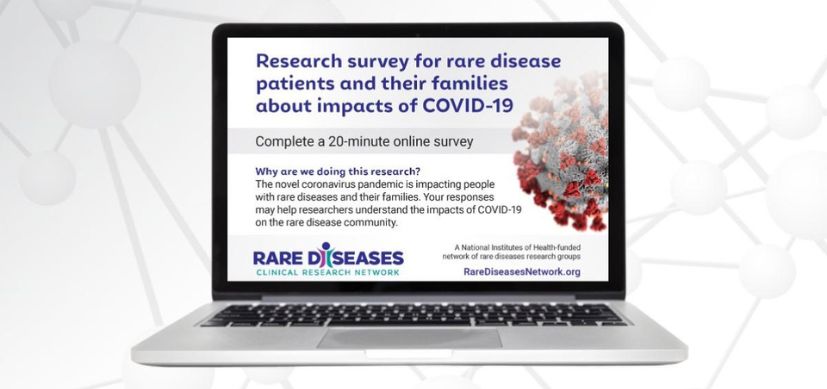Rare Disease Survey Reports COVID Pandemic Impact
Post Date: February 26, 2024 | Publish Date:

Findings from RDCRN will help us better support people who live with rare diseases
In May 2020, the National Institutes of Health-funded Rare Diseases Clinical Research Network (RDCRN) launched an online survey to find out how the COVID-19 pandemic impacted individuals with rare diseases, their families, and their caregivers.
Now, researchers are sharing what they’ve learned, publishing the results on Feb. 14, 2024, in the Journal of Medical Internet Research Public Health and Surveillance. Their insights—which address access to care, medication use, and mental and physical wellbeing—are helping us understand the unique challenges faced by this population and how we can better support them.
Maurizio Macaluso, MD, DPH, co-principal investigator for the network’s Data Management and Coordinating Center (DMCC), which is run by Cincinnati Children’s, notes the need for continued monitoring: “Long-term effects of the infection—’long COVID’—are showing us that the virus is changing, adapting, and spreading. We need to make sure that we have good data on how these changes affect people who live with rare diseases.”
Read more about the survey on the RDCRN website.
The survey was released in advance of Rare Disease Day 2024, which is observed every year on February 28 (or February 29 in leap years like 2024), the rarest day of the year. An estimated 300 million individuals worldwide are affected by one of the more than 7,000 rare diseases.
Cincinnati Children’s plays a leading role in the RDCRN. In 2019, Cincinnati Children’s received a $28 million grant to serve as the DMCC for the collaborative.
The Consortium of Eosinophilic Gastrointestinal Disease Researchers (CEGIR), one of RDCRN’s 20 individual research consortia, is based at Cincinnati Children’s. In addition to this work, many scientists throughout Cincinnati Children’s are pursuing projects aimed at improving outcomes for children with rare diseases. Recent highlights include:
Borrowing Historical Controls Could Accelerate Rare Disease Research
Rare disease research faces challenges due to limited patient populations, making randomized controlled trials slow and costly. However, clinical trials could be accelerated using historical controls alongside concurrent controls.
The study, published March 17, 2023, in Clinical Trials, re-analyzed data from the MILES trial, which resulted in the FDA’s approval of sirolimus for treating lymphangioleiomyomatosis (LAM). The MILES trial needed 964 days to enroll 89 patients and conduct the final analysis. In an efficient alternative design, however, the trial would have needed 34 fewer participants and could have been completed five months sooner in part by replacing a placebo arm with matched historical controls.
The study was led by first author Nusrat Harun, PhD, and senior author Maurizio Macaluso, MD, DrPH.
TSLP Inhibitors Emerge as Potential Therapy for Eosinophilic Esophagitis
A study exploring how the cytokine TSLP enhances allergic inflammatory response in human immune cells suggests that a blood test can be developed to identify a subset of people with eosinophilic esophagitis (EoE) who may benefit from high-cost monoclonal antibody treatments.
The study, published online Sept. 12, 2023, in Science Signaling, was led by first author Yrina Rochman, PhD, and corresponding author Marc Rothenberg, MD, PhD, director of the Division of Allergy and Immunology.
GEMINI Study Supports Whole Genome Sequencing for Diagnosing Genetic Disorders
Diagnostic detectives using rapid-but-limited genetic tests found causes for undiagnosed rare diseases in about 27% of cases. But using whole genome sequencing does a better job: producing critical information in 49% of cases, according to the recent GEMINI research study.
Detailed findings were published July 11, 2023, in JAMA. Cincinnati Children’s was a large source of participating patients for the study. Jae Kim, MD, PhD, co-director of the Perinatal Institute and Division Director of Neonatology at Cincinnati Children’s, was a co-author.
Organoid Tech Sheds Light on a Rare, Fatal Kidney Disorder
Autosomal recessive renal tubular dysgenesis (AR-RTD) is an extremely rare inherited disorder that results in missing or severely malformed proximal tubules that the kidney uses to remove wastes and return needed substances to the bloodstream. Nearly all those affected die in utero or within the first few days after birth.
Now, a study published Dec. 9, 2023, in Nature Communications, reports that a developmental delay in kidney vascularization basically starves growing tubules during a crucial point in their development, which appears to drive the disease.
The study was led by first author Naomi Pode-Shakked, MD, PhD, a former research fellow at Cincinnati Children’s and corresponding author Raphael (Rafi) Kopan, PhD, Division of Developmental Biology.
New Mouse Model Accelerates Research to Treat Rare Vascular Tumors—and More
When infants or children are affected by a class of rare, fast-growing vascular tumors associated with a mutation in the gene GNAQ, they experience extensive disfigurement, chronic pain and a life-threatening complication known as the Kasabach-Merritt phenomenon (KMP).
Now, experts at Cincinnati Children’s have developed a genetically modified mouse that mimics the formation of these vascular tumors, including the KMP complication. Further, by studying this animal model, the team has discovered a treatment that may eventually help treat affected children.
Details were published April 6, 2023, in Nature Communications. The research was led by first author Sandra Schrenk, PhD, and corresponding author Elisa Boscolo, PhD, both from the Division of Experimental Hematology & Cancer Biology.
Read more about rare disease research at Cincinnati Children’s
Milestone: 20 years of Rare Diseases Clinical Research Network (Watch Video)






